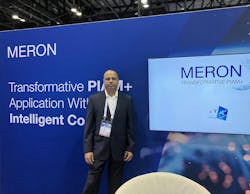Meron, newly launched brand at GSX, looks to disrupt PIAM landscape
Meron is a new entry in the cyber-physical security marketplace making its first public introduction at GSX 2024.
The company is demonstrating a new solution for Physical Identity and Access Management (PIAM), branded PIAM+ at the conference (booth #1955).
Meron has been launched by industry veterans Sharad Shekar and Imran Rana, who are pushing to usher in the next generation of AI-driven driven PIAM and security incident management that overcomes the longstanding shortfalls of legacy solutions.
Shekhar is former CEO of Pelco and General Manager at Cummins who has led global businesses in the technology, automotive, manufacturing and security industries. Shekar has led organizations through major transformation involving strategic repositioning, new product development, operational excellence, and aggressive sales and earnings growth in competitive environments.
Rana has over 27 years of sales, consulting, software implementation and digital transformation experience. As the former Chief Revenue Officer at Soloinsight, Rana oversaw the global sales strategy and execution for the CloudGate platform.
SecurityInfoWatch Managing Editor John Dobberstein caught up with Shekhar and Rana ahead of GSX to talk about Meron’s launch and what the company’s technology offers to the industry.
Q: Give us some background on Meron, your vision behind the company and what gaps you are trying to fill?
Shekhar: Meron was conceived in 2023 amidst the course of several large consulting projects I was involved with for various physical- and cyber security clients.
Through many in-depth conversations about security challenges and needs, it became obvious that several large organizations were struggling with new demands for heightened physical access and identity management -- with specific complexities related to compliance and audit requirements.
One of the key challenges was managing physical access provisioning and maintaining it over the life cycle of an individual’s employment with the changing roles and geographic access becoming more prolific and difficult to process manually.
After close analysis of currently available PIAM solutions, many shortfalls inherent in legacy PIAM platforms were identified that resulted in numerous failed PIAM deployments that were, quite frankly, based on promises they could not fulfill.
With such a strong market opportunity poised for exponential growth, the timing and opportunity seemed right to deliver ‘a better mousetrap’ by developing a true modern PIAM system. So Meron was formed, and we assembled a team of brilliant developers to write a new PIAM solution that went beyond the horizon of current platforms. We call it PIAM+.
Meron PIAM+ evolves PIAM from monolithic to microservices architecture, filling in all the gaps related to Identity lifecycle management with a goal to dramatically improve the user experience and accommodate self-service administration. We believe MERON PIAM+ changes the status quo by delivering all that PIAM has promised to be.
Q: What are the challenges seen today with PIAM applications and what are you doing to change that?
Rana: Meron PIAM+ resolves the significant shortfalls of legacy PIAM applications related to scalability, integration, security, cost efficiency and the overall improvement of the user experience. The following is a list of the most significant user challenges we set out to overcome with this revolutionary solution:
- Incomplete identity lifecycle management: Eliminate the gaps in the lifecycle management and the manual custom patchwork-laden deployments at customer sites, and the high support and maintenance costs associated with these processes.
- Cyber vulnerability: PIAM+ allows each microservice to have its own security measures tailored to meet the needs of each application, so if one microservice is ever compromised, it does not necessarily compromise other services.
- Limited insights: Meron PIAM+ is an AI and data centric platform that delivers real-time and offline analytics to derive actionable insights and detect anomalies before they materialize into potentially damaging events.
- Need for incident tracking: Integrating a real-time built-in incident management application with PIAM+ allows users to effectively manage and track all incident types.
- Legacy technology stack: Meron PIAM+ employs AI co-pilots to automatically manage the platform and system, anomaly detection, self-healing of any fault, etc.
- Limited scalability and inflexibility: Unlike legacy PIAM software that is often built on monolithic architecture, PIAM+ is built with microservices architecture that is easily and cost-effectively scalable.
- Difficulty upgrading: Meron PIAM+ offers a straightforward upgrade path as each microservices can be individually upgraded automatically while the system is up and running, minimizing system downtime.
- Slow/costly implementation: Meron PIAM+ is designed for rapid deployment utilizing preconfigured templates, workflows and rules resulting in deployment times that are up to 300% faster than existing PIAM applications.
- Poor/slow performance: PIAM+ features a distributed data and event streaming platform to handle a high throughput of messages with minimal latency, ensuring data durability and reliability even in the event of hardware failures.
- Lack of API support: Meron PIAM+ offers modern APIs that make integration with newer IT systems, cloud-based services, and IoT devices fast, easy and more efficient. T
- Inability to support modern security paradigms: Meron PIAM+ enables users to develop and enforce zero trust models to best protect people and assets.
- Limited innovation: Unlike Meron PIAM+, older PIAM applications are built on outdated technologies, which can make maintenance costly and resource intensive, resulting in unwanted vendor lock.
Q: Explain how data science, artificial intelligence and micro-services architecture are being leveraged to create PIAM+. What do the capabilities of a “new breed” of PIAM look like?
Shekhar: Meron PIAM+ combines the best in data science, AI and microservices architecture to deliver a new highly scalable, intelligent, and efficient PIAM solution that goes far beyond legacy software.
While data science focuses on collecting, processing, and analyzing large sets of data to derive meaningful insights, AI performs complex tasks that automates and simulates “human” intelligence for decision-making, natural language processing, image recognition and problem-solving. The microservices architecture employed by Meron PIAM+ is built as a collection of loosely coupled services to ensure scalability, maintainability and resilience.
For example, Meron PIAM+ data science enables Identity behavior analysis with respect to physical access activities, AI then derives recommendations to ease tasks for that identity (such as making recommendations related to each physical access request), and the platform’s microservices execute and process each request with the appropriate related service such as access request, access approvals, audits etc.
This combination drives our innovative platform with a powerful framework for building intelligent, scalable, and agile PIAM+ applications.
Q: Why is it important to have cloud based / on-prem based models that run continuously even during the upgrade cycle?
Rana: Many customers still prefer on-prem models due to security reasons. Many move to cloud. Whether running on-prem or in the cloud, Meron PIAM+ runs continuously even during the upgrade cycle. The presents several distinct advantages:
- Our new PIAM+ solution minimizes downtime and ensuring continual availability to maintain business continuity
- Seamless upgrades and deployment allow each service to be upgraded independently as upgrades are pushed. This enables the application to virtually run forever. For example, Meron PIAM+ does not need to be brought down if there is an enhancement in the Access Request or any other microservice.
- Operational efficiency is maintained through continuous operation, reducing the need for manual intervention, such as scheduling downtimes. This all but eliminates service disruptions that could affect multiple teams, effectively increasing overall operational efficiency.
- Data integrity is maintained by eliminating interruptions in data flow or AI model operation during an upgrade, which can result in data corruption or loss. Continuous operation ensures that data pipelines and models run without disruption.
Q: Why are you attending GSX this year and what products or technology do you plan to feature? What is your message to the market?
Shekhar: We are launching Meron and our flagship application PIAM+ at GSX 2024, which has been in development since 2023 after witnessing a virtual explosion in AI technology and its applicability for an advanced new identity management solution.
Meron PIAM+ infuses subtle automation into every process of the Identity lifecycle management. We plan to demonstrate PIAM+ at GSX 2024 along with an Enterprise Visitor Identity Management product with AI enabled co-pilot.
Our value proposition and message to the security professionals is simple. Meron PIAM+ reduces overhead and costs dramatically while significantly improve identity management processes and accuracy. We are challenging the status quo. Why tolerate failed PIAM deployments?
Why are legacy PIAM applications non-scalable, and why do they often break down with high transactional data volume? Why are legacy players pushing old, outdated technology to the customers? Our new PIAM+ application resolves all of these longstanding issues. Not just more promises, we can deliver on our promises.
About the Author
John Dobberstein
Managing Editor/SecurityInfoWatch.com
John Dobberstein is managing editor of SecurityInfoWatch.com and oversees all content creation for the website. Dobberstein continues a 34-year decorated journalism career that has included stops at a variety of newspapers and B2B magazines. He most recently served as senior editor for the Endeavor Business Media magazine Utility Products.


